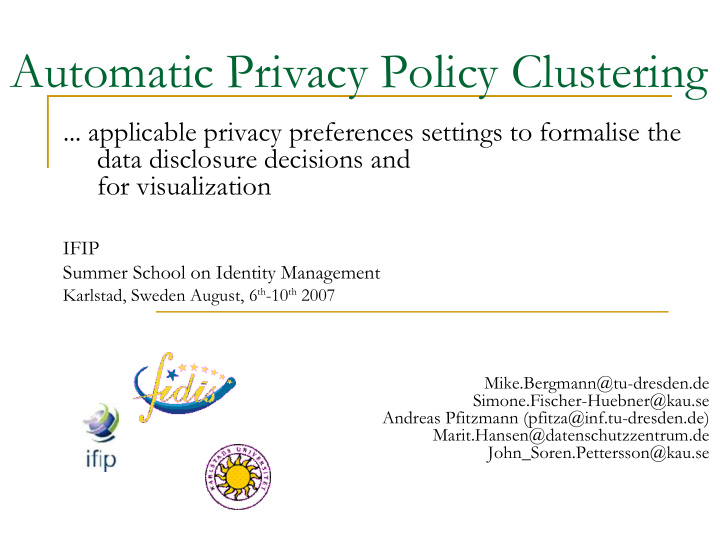



Automatic Privacy Policy Clustering ... applicable privacy preferences settings to formalise the data disclosure decisions and for visualization IFIP Summer School on Identity Management Karlstad, Sweden August, 6 th -10 th 2007 Mike.Bergmann@tu-dresden.de Simone.Fischer-Huebner@kau.se Andreas Pfitzmann (pfitza@inf.tu-dresden.de) Marit.Hansen@datenschutzzentrum.de John_Soren.Pettersson@kau.se
Automatic Privacy Policy Clustering Digital life becomes reality, More and more online services More and more personal data is released to use these services Data release conditions are not transparent enough Web 2.o increases the need towards effective IdM but how to create the policies
Automatic Privacy Policy Clustering Analysis of existing application scenarios Definition of the necessary “Sets of Data” Find the common structure ( Similarities/Differences ) Analyse of the application scenarios Define the main settings Discussion: Scenario III as the “MAX” ?! Split existing business processes into subtasks Example implementation
Typical Application Scenarios Business – prof. surrounding, full, authentic PII eShopping – semi-prof. surrounding, full, authentic PII SocialNetwork – non-prof.; no PII necessary, but released Download – non-prof.; no PII necessary Blog – non-prof.; no PII necessary, but collection becomes PII eMail – non-prof.; no PII necessary, but collection becomes PII Membership – semi-prof. surrounding, full, authentic PII … Further – all others, like licensing, collaboration, news reading...
Application Scenarios - Distribution
Similarities & Differences
Derived Privacy Preferences I No PII Transaction pseudonyms are used, possibly linkable Personal data are not released Examples: weblog; create an anonymous Wikipedia entry No PII, but linkable Use of (role–) relationship pseudonyms (not identifying the user) Examples are web mailers, news panels Difficult/impossible for the user to keep PII secret over time
Derived Privacy Preferences II Disclose necessary PII Minimal amount of PII (not sensitive) binded to dedicated purpose Strict no further transfer policy Data release only to “trusted” partners Explicit user consent Example is to book a book online Disclose additional PII (related to III) Add. (not sensitive) PII for add Services beside the primary service. Data release only to “trusted”partners Explicit user consent Transfer to “trusted” recipients only Example: customer care program
Summary
Discussion - Scenario III as the “MAX” ?! Transfer: Each new recipient could be seen as the one and only partner Purpose: Each new (additional) purpose could be seen as a new service and becomes „primary“ from there Cluster the business process accordingly
Clustering I Example for IV – Buying a Book Order Payment Delivery Split it into Subtasks to achieve Scenario III Order (Customer N°, ISBN; Merchant, strict no further transfer) Payment (CC data, bank, strict no further transfer) Delivery (Address, UPS, strict no further transfer)
Clustering II
Implementation Proposal Wizard like approach:
Outlook Find a formal description „Template“ and „Preset“ as formal vehicle: Template: „is a formal description of the requirements a certain service provider has to grant access to a specific protected resource promising an attached data handling policy .” Preset: „ is a set of personal data for a dedicated template and the related privacy preferences for one or more specific service requests.” Formal protocol development to unify the clustered disclosure process User acceptance testing
Thanks for your attention Send comments to mike.bergmann@tu-dresden.de
Recommend
More recommend